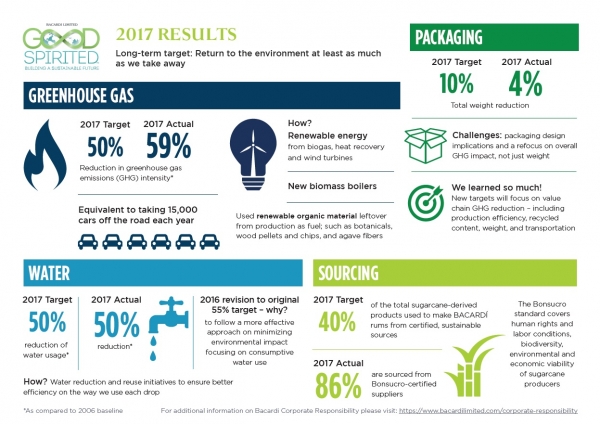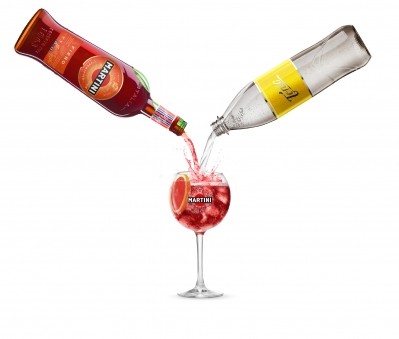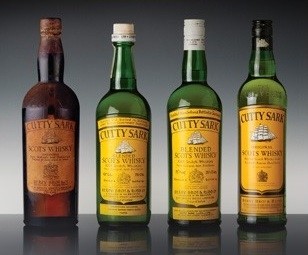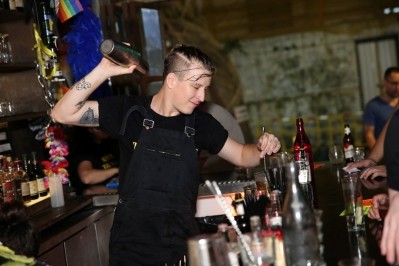Sustainability spotlight
Bacardi on sustainability in packaging: ‘We’ve learned a lot about the importance of addressing more than just weight’
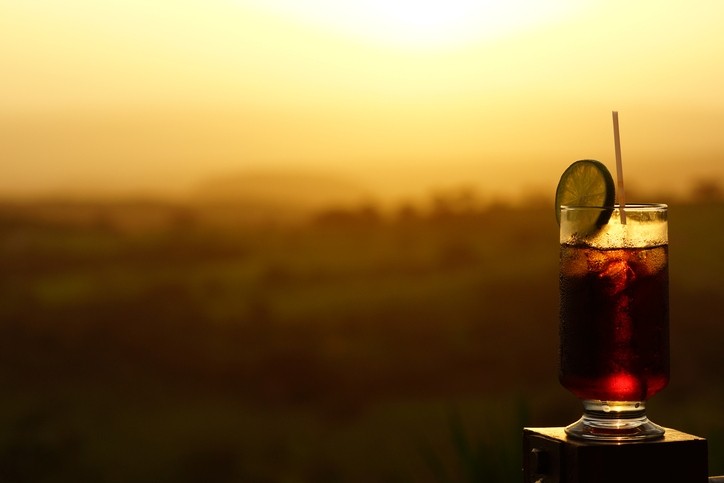
Having set out a goal to reduce packaging by 10% between 2008 and 2017, the spirits giant only realised a 4% reduction: a result of refocusing its efforts from weight reduction alone to wider greenhouse gas emissions (GHG).
Furnace efficiency and transportation logistics all have a part to play in increasing the sustainability credentials of packaging, it says.
Across its business, it has made GHG reductions that are the equivalent to taking 15,000 cars off the road each year.
The bigger picture
Headquartered in Hamilton, Bermuda, Bacardi’s portfolio includes brands such as Martini, Bombay Sapphire, Bacardi rum, Grey Goose Vodka and Patron tequila. Founded in 1862, the family-owned company operates more than 20 production facilities across 11 countries.
It says its missed glass packaging weight reduction target was mainly down to two factors: new packaging design implications and a refocus to overall GHG impact instead of only weight reduction.
“Bacardi identified contributors to GHG beyond glass weight, including furnace efficiency and transportation logistics,” Rick Wilson, senior vice president of Corporate Responsibility at Bacardi, told BeverageDaily.
“This learning has been key in developing new goals that focus on supplier collaboration and glass weight reduction, including production efficiency, recycled content, weight, and transportation.
“When we developed the goal in 2014, we didn’t take our full product value chain into account, including new and future brand designs implemented by our marketing teams.
"Moving forward, we will work with suppliers on the key contributors to GHG, including transportation logistics and efficiencies in power, along with weight, to make sure we address all factors contributing to GHG.”
GHG reductions: the equivalent of taking 15,000 cars off the road each year
And Wilson says it’s these wider greenhouse gas emissions over the last decade – both in packaging and across the business - that Bacardi is most proud of when it comes to its sustainability initiatives. Its reduction in greenhouse gas emissions at the end of 2017 was 59%, compared to a 2006 baseline – the equivalent of taking 15,000 cars off the road each year.
“This includes major investments at our main distilleries, including installing biomass boilers and focusing on renewable energy from biogas, heat recovery systems, and wind turbines.”
For example biomass boilers were installed at the Tequila Cazadores facility in Mexico, and Aberfeldy and Royal Brackla Scotch whisky distilleries in Scotland. Instead of using oil, renewable organic material such as botanicals, wood pellets, wood chips and agave fibers leftover from production are used as fuel for the biomass boilers. In the UK, Italy and Germany Bacardi has implemented some green electricity contracts – including hydro, solar and wind – to reduce carbon footprint.
Initiatives were implemented globally at Bacardi distilleries, bottling lines, visitor centers, and offices for energy reduction.
“During this process we found significant support among our employees to change the way we worked to reduce our impact on the environment," said Wilson. "Now we have hundreds of green champions across our facilities ensuring we continue to make the changes needed to keep us sustainable."
“In addition, being named among the most reputable companies in the world for that past six years, as part of the annual Global RepTrak 100 list compiled by the Reputation Institute (RI) and published in Forbes, is an accolade we are all proud of.”
Better together
Wilson says that beverage industry giants can work together on common goals to achieve a greater impact when it comes to sustainability and social responsibility.
“The beverage industry works together through membership in the Beverage Industry Environmental Roundtable (BIER) to share best practices and work together to reduce all our environmental impacts," he said.
“While we may compete commercially, we think we can have a greater impact if we work together since we have similar goals. This also includes our approach to helping reduce the harmful use of alcohol. We partner with other spirits companies and those from the beer and wine industry through our work with the International Alliance for Responsible Drinking, as we believe working together will have a greater impact globally.”
Earlier this year Bacardi announced it was aligning its corporate strategy with UN sustainable development goals.
“By aligning our corporate responsibility strategy with 10 of these goals we believe we can be most impactful in, we reinforce the important role of the private sector - in partnership with governments and civil society - in achieving the goals,” said Wilson.
Bacardi: key sustainability achievements
In 2014 Bacardi set out its Good Spirited environmental sustainability initiative with specific goals in sourcing, packaging and operations to be achieved by 2017 and 2022 – ‘under the vision to return to the environment as least as much as we take away’.
- GHG Emissions: Bacardi cut GHG intensity from manufacturing operations in half more than a year earlier than its 2017 target. At the end of December 2017, the reduction was at 59%, compared to 2006 baseline. This reduction is equivalent to taking 15,000 cars off the road each year or reducing oil use by 165,000 barrels annually.
- Water Usage: The 50% reduction of water use target by the end of December 2017 (compared to the 2006 baseline) was achieved. From water reduction initiatives to water reuse, projects were implemented across operations to ensure better efficiency in how water is used. (Note: a revision to the target was made in 2016 from 55% to 50% to focus on “consumptive” water use reduction, which measures water that is not returned to the original water source).
- Waste: A target of achieving Zero Waste to Landfill from manufacturing sites by 2022 was also set in 2014. As of December 2017, 99.8% of the waste generated from Bacardi operations was diverted from landfills (only 0.2% sent to landfill), with one-third of sites already achieving Zero Waste to Landfill status. Further initiatives focusing on reduction, reuse, and recycling are in place for the remaining sites to achieve this status by 2022.
- Packaging: Despite efforts to reduce GHG through glass weight reduction, Bacardi was not able to meet the 10% packaging reduction goal between 2008 and 2017. As of the end of December 2017, the reduction was at 4%. This missed target was mainly driven by two factors: new packaging design implications and a refocus to overall GHG impact instead of only weight reduction.
- Sourcing: Sugarcane-derived products are the most significant agricultural supply for the company, and Bacardi says it works with suppliers and industry groups to ensure all suppliers achieve certification to the Bonsucro standard covering human rights and labor conditions, biodiversity, environmental, and economic viability of sugarcane producers. As of 2017, 86.3% of sugarcane-derived products used to make BACARDÍ rums were sourced from Bonsucro-certified suppliers, ahead of the original 2017 target of 40%.

